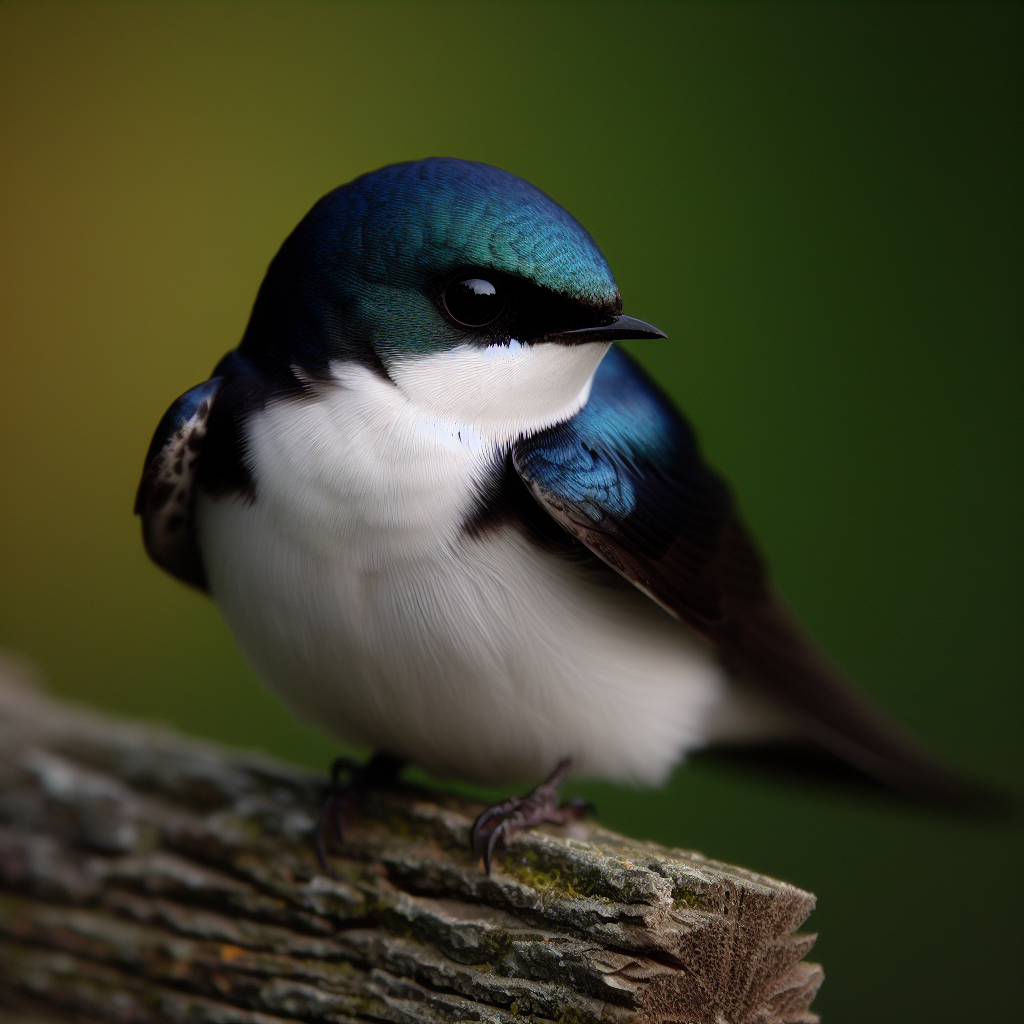Most beautiful small birds - Sykalo Eugen 2024
Tree Swallow (Tachycineta bicolor)
Identification:
- Species name: Tree Swallow
- Scientific name: Tachycineta bicolor
- Family: Hirundinidae (Swallows)
- Order: Passeriformes (Songbirds)
- Subclass: Neornithes (Modern birds)
- Class: Aves (Birds)
Description:
- Size: Petite acrobat, about 12-14 cm (4.7-5.5 in) long with a wingspan of 30-35 cm (12-14 in).
- Body shape: Streamlined and agile, with long, pointed wings, a short, forked tail, and a small, black, slightly downcurved beak perfect for catching airborne prey.
- Plumage color:
Males: Dazzling iridescent blue-green upperparts, contrasting with their snow-white underparts and black wings and tail.
Females: Duller overall, with less iridescence and more brownish upperparts.
Both sexes have distinctive white underbellies and small black legs.
Large, dark brown eyes.
Behavior:
- Method of feeding: Primarily aerial insectivores, hawking flying insects with acrobatic dives and twists. May also glean insects from leaves and branches.
- Reproduction: Build cup-shaped nests in cavities, often abandoned woodpecker holes or birdhouses. Lays 2-4 white eggs with dark speckles. Both parents care for the young.
- Movement: Migratory, breeding in North America and wintering in Central and South America. Some local movements within breeding range in response to food availability.
- Communication: Pleasant chirps and twitters, with males having a more complex song used for territorial defense and courtship.
Ecology:
- Habitat: Open areas with access to flying insects, including fields, meadows, wetlands, parks, and even backyards with nest boxes.
- Diet: Primarily flying insects, such as flies, mosquitoes, bees, and butterflies. May also take spiders and other small invertebrates.
- Hunting methods: Dives and swoops through the air with incredible agility, snapping up insects mid-flight. May also glean insects from leaves and branches or even hover to snatch them.
Distribution: Breeds across most of North America, from Alaska to southern Mexico. Winters from southern Mexico to Panama.

The Tree Swallow, a feathered flash painting cerulean skies with acrobatics and tireless energy, might seem like a simple insect hunter at first glance. But beneath its sleek blue-green plumage and seemingly graceful wings, lies a treasure trove of surprising facts and adaptations that will transform this sky acrobat into a captivating aerial master, hidden feast master, and unexpected plant enthusiast in your eyes.
Masters of the Aerial Ballet: Forget clumsy hops; Tree Swallows reign supreme in the domain of sun-dappled clouds and vast blue expanses. Their powerful wings and surprisingly acrobatic skills propel them through the air with breathtaking agility, swooping and diving like feathered fighter jets on miniature hang gliders. Imagine them as sky ballet dancers with built-in miniature jetpacks and an innate love for synchronized aerial performances.
Hidden Feasting Technique: Don't underestimate their dietary flexibility! While insects are a staple, Tree Swallows are opportunistic omnivores, readily adapting their menu to seasonal bounty. From juicy fruits and tender shoots to pollen and even the occasional small fish, their varied appetite keeps them fueled for energetic foraging sessions. Think of them as feathered aerial gourmands with built-in miniature buffets hidden within the windswept currents.
Singing with Sky Spirit: Their calls aren't just chirps and whistles. Tree Swallows possess a distinctive and surprisingly complex repertoire, with clear, twittering songs, intricate trills, and even a signature "chu-wee" duet call that echoes melodically through the air. Their voices rise above the open skies like feathered wind chimes, serenading the sun-dappled clouds with their playful spirit and vibrant partnership.
Unexpected Plant Enthusiasts: They're not just bug-chasing nomads. Tree Swallows, in a surprising twist, play a vital role in plant pollination. Their frequent visits to flowers, while primarily seeking nectar, inadvertently transfer pollen between blossoms, contributing to the reproductive success of countless plant species. This feathered sky courier, with its built-in miniature pollen-spreading kit, becomes an unexpected matchmaker amongst the windswept meadows.
Champions of Ecosystem Health: They're not just colorful residents. Tree Swallows play a vital role in the health of open ecosystems. Their insect feasting controls pest populations, while their droppings fertilize the soil, making them feathered sky doctors with built-in miniature pest-control systems and environmental beautification kits.
Cultural Charmers: Across North America and Europe, the Tree Swallow has held diverse cultural significance. In some regions, its acrobatic flights inspire admiration for its grace and agility. In others, its presence in open fields is seen as a symbol of hope and new beginnings.
Unexpected Regional Variations: Did you know? Not all Tree Swallows are the same! Different populations across their vast range show subtle variations in plumage color and call patterns, adding a touch of feathered diversity to this adaptable species.